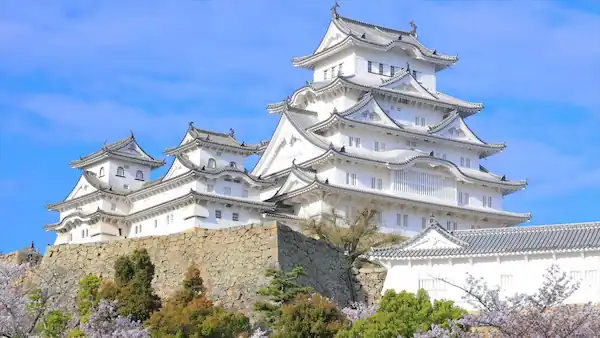A Gigantic Keyhole-Shaped Mystery of Kofun
Imagine, spread out before you, a colossal structure so vast that its full form cannot be grasped from ground level.
This is the “Mausoleum of Emperor Nintoku” (officially known as Daisen Kofun, or Daisenryo Kofun), quietly nestled in Sakai City, Osaka Prefecture.
This ancient tomb, the largest in Japan, is truly a mystery that transcends time.
Its scale rivals that of Egypt’s Great Pyramid of Giza and China’s Mausoleum of the First Qin Emperor, and in terms of planar area, it ranks as one of the largest burial mounds in the world.
This magnificent site was inscribed as a UNESCO World Heritage Site on July 6, 2019, as part of the “Mozu-Furuichi Kofun Group: Mounded Tombs of Ancient Japan.”
This was the first World Heritage registration in Osaka Prefecture, a testament to the international recognition of its historical and cultural value.
Table of Contents
The Mausoleum of Emperor Nintoku boasts a total length of approximately 486 meters (some sources say 525m), with the rear circular mound reaching a height of about 39.8 meters (or 35.8m), and the front rectangular section a width of about 307m.
Despite its immense size, its most distinctive feature – the “zenpō-kōen-fun” or keyhole shape – is entirely invisible from the ground.
Multiple moats and the dense forest covering the burial mound conceal its true form, cloaking it in profound mystery.
This “invisibility” from ground level further enhances the allure of this gigantic kofun (ancient tomb), prompting us today to wonder what intentions drove the ancient people to create such a shape.
What makes this colossal monument even more remarkable is its astonishing state of preservation.
For over 1,600 years, the Mausoleum of Emperor Nintoku has remained largely untouched, retaining its original appearance.
This unparalleled preservation is the very root of its mystique and stands in stark contrast to the fate of many ancient ruins around the world, reflecting a special reverence fostered by Japanese culture.
- Official Name (Imperial Household Agency designation)
Mozu no Mimihara no Naka no Misasagi (The Central Mausoleum of Mozu no Mimihara)
An Untouchable Sanctuary: Strict Management by the Imperial Household Agency and Japanese Reverence
The Mausoleum of Emperor Nintoku is more than just an archaeological site.
It is officially designated by the Imperial Household Agency as “Mozu no Mimihara no Naka no Misasagi,” revered as the mausoleum of the 16th Emperor Nintoku.
This designation carries the weighty implication that the kofun is Imperial property and an object of ritual worship.
Consequently, public access is strictly restricted, and the burial mound, surrounded by multiple moats and dense woods, has remained almost entirely undisturbed, quietly marking the passage of time.
This sacred status is the primary reason why large-scale excavations have been intentionally avoided.
Unlike many other ancient sites, the preservation of its sanctity and integrity as an imperial mausoleum has been paramount for the Nintoku Tomb.
However, slight changes have recently occurred in this strict management regime.
For about the past decade, the Imperial Household Agency has begun to permit limited access for surveys by local governments and researchers.
Particularly groundbreaking was a joint excavation project conducted with Sakai City in October 2018.
This marked the first instance of the Imperial Household Agency allowing an external body, even a local government, to conduct research on the Nintoku Tomb, greatly exciting ancient history enthusiasts.
While these investigations were primarily aimed at the conservation and maintenance of the kofun, their findings were astonishing.
On the flat causeways between the moats, it was discovered that small stones were meticulously laid, and furthermore, rows of cylindrical haniwa (clay figures) approximately 35cm in diameter were unearthed.
The presence of these haniwa rows suggests that the kofun in its original state, with haniwa lining both sides of the causeways, presented an unimaginably grand spectacle, attesting to the immense power of the individual interred within.
Although these discoveries offer a tantalizing glimpse into the kofun’s secrets, the full picture of the mound’s interior and its comprehensive mysteries remain elusive.
This characteristic of an “untouchable sanctuary” further deepens the mystique surrounding the Mausoleum of Emperor Nintoku.
The absence of large-scale excavations means that ultimate questions, such as the confirmed identity of the interred individual and the contents within, remain unanswered.
This situation, where one of the world’s largest tombs continues to conceal its core secrets, stimulates modern curiosity and exudes an unending fascination with ancient enigmas.
This “untouched” state stands in stark contrast to the fate of other famous ancient sites worldwide.
The pyramids of Egypt, for example, despite their magnificence, have been subject to looting, excavation, and even destruction over millennia.
However, the Mausoleum of Emperor Nintoku has retained its near-original form for over 1,600 years.
This extraordinary long-term preservation is not merely a matter of physical security.
It is an expression of the unwavering respect for the Emperor and the Imperial Family deeply rooted in Japanese culture.
This intangible “respect,” a form of cultural guardianship, has acted as a far more potent protective force than any physical barrier, safeguarding this massive tomb from the ravages of time and human interference.
While historical records indicate that the Daisen Kofun was accessible to the public before the Edo period (1603-1868), the underlying reverence has always served as a protective force.
A Giant of History Across Time: The Mausoleum of Emperor Nintoku and its Surrounding Kofun Group
Historical Context and Significance
The Mausoleum of Emperor Nintoku is believed to have been constructed in the 5th century, specifically between 441 and 460 CE.
This era falls within the mid-Kofun period of Japanese history, characterized by political consolidation and remarkable technological advancements.
While the Imperial Household Agency designates this colossal tomb as the mausoleum of the 16th Emperor Nintoku, scholarly debate regarding the actual interred individual continues.
However, according to the Nihon Shoki (Chronicles of Japan), Emperor Nintoku was known for his benevolent rule, symbolized by an anecdote where he exempted the populace from taxes upon observing no smoke rising from their kitchen hearths.
He is also credited with large-scale civil engineering projects such as the excavation of the Naniwa no Horie canal and the construction of the Mamuta no Tsutsumi embankment for flood control in the Kawachi Plain, as well as land reclamation.
His achievements during his reign are considered befitting of such a massive tomb.
As mentioned, the Mausoleum of Emperor Nintoku is a central component of the “Mozu-Furuichi Kofun Group,” inscribed as a World Heritage Site in 2019.
This international recognition underscores the universal value and decisive role this kofun plays in understanding ancient Japanese history and culture.
Scale and Structure of the Mausoleum of Emperor Nintoku
The Mausoleum of Emperor Nintoku is an archetypal example of Japan’s unique “zenpō-kōen-fun” (keyhole-shaped tomb), a distinctive form built throughout the Kofun period.
It boasts a staggering total length of about 486m (some sources say 525m), with the rear circular mound having a diameter of approximately 249m and a height of about 35.8m (some say 39.8m).
The front rectangular section extends to a width of about 307m, making it not only the largest kofun in Japan but also one of the largest burial mounds globally.
This enormous mound was constructed in three tiers and is encircled by three moats.
Although the current outer moat was re-dug during the Meiji era (1868-1912), its grand appearance still conveys the power and technological prowess of antiquity.
A walking path of approximately 2.8km circuits the kofun, taking about an hour to complete, allowing visitors to experience its immense scale firsthand.
Surrounding Kofun Group (Mozu Kofun Group)
The Mausoleum of Emperor Nintoku is not an isolated entity but is situated at the heart of the extensive Mozu Kofun Group.
This cluster features many other significant kofun.
Notably, the Mausoleum of Emperor Nintoku, along with the Mausoleum of Emperor Hanzei (Tadeiyama Kofun) to its north and the Mausoleum of Emperor Richu (Ishizuoka Kofun) to its south, are collectively known as the “Mozu no Mimihara Sanryō” (Three Imperial Mausolea of Mozu no Mimihara) and are thought to be closely related.
The Mausoleum of Emperor Richu, with a total length of about 365m, is the third largest in Japan, while the Mausoleum of Emperor Hanzei is a keyhole-shaped tomb 148m in length.
The Mozu Kofun Group also includes many other large keyhole-shaped tombs such as Nisanzai Kofun (Japan’s 7th largest), Gobyoyama Kofun, and Itasuke Kofun.
Furthermore, more than 10 smaller kofun known as “baichō” (or “baizuka,” meaning attendant or satellite tombs) have been identified around the Mausoleum of Emperor Nintoku.
These baichō are believed to contain individuals closely associated with the great king, further emphasizing the authority and scale of the Nintoku Tomb.
For instance, Nagayama Kofun is considered a baichō of the Nintoku Tomb and is a keyhole-shaped kofun about 100m long with its own surrounding moat.
The existence of these kofun in a group suggests not just individual burial sites, but a highly organized and hierarchical society under the powerful Yamato regime.
The fact that many kofun, regardless of size, share the common keyhole shape unique to Japan indicates a shared political ideology among the ruling class and standardized burial customs.
This collective monumentality eloquently demonstrates the formidable power of the ancient state.
Moreover, despite its designation by the Imperial Household Agency as Emperor Nintoku’s mausoleum, the actual identity of the interred individual remains a subject of academic debate.
The fact that the world’s largest tomb has yet to definitively reveal the identity of the person resting within simultaneously showcases the depth of history and the limits faced by modern archaeology.
This unresolved aspect further enhances the kofun’s mystique and continues to fire the imaginations of history enthusiasts.
The Ancient Blueprint Seen from Above: The Mystery of Similar Shapes and Astonishing Construction Technology
One of the most astonishing aspects of keyhole-shaped tombs (zenpō-kōen-fun), including the Mausoleum of Emperor Nintoku, is how their unique “keyhole” form is reproduced with surprising precision across kofun of various sizes.
How did ancient people, without the technology to view the entire structure from above as we can today, design and accurately construct such complex and proportionally similar massive edifices?
This question is one of the greatest enigmas of the kofun and speaks to the marvel of ancient Japanese civil engineering.
Although ancient surveying techniques were primitive by modern standards, it is evident they possessed highly sophisticated spatial awareness and design principles.
It’s believed that a method called “katawari,” using stakes and ropes, was employed to outline the kofun.
Horizontal planes were determined by filling grooves or wooden troughs with water, and angles were decided using the ratios of right-angled triangles (base to height).
There’s also a theory that the basic unit of length was the “hiro,” the span of an adult’s outstretched arms, and that massive structures like the Nintoku Tomb might have been designed using multiples of such basic units.
The ability to consistently replicate this complex keyhole shape at different scales suggests that ancient Japanese engineers had a very refined understanding of geometry, abstract spatial planning, and standardized measurement systems.
This means they weren’t just building large mounds of earth but were faithfully adhering to precise design principles imbued with symbolic meaning.
Achieving such monumental accuracy with simple tools like ropes, stakes, and water levels is a testament to their deep understanding of their environment and materials, and their advanced intellectual and technical capabilities.
Their accomplishments in an era without modern surveying equipment are truly phenomenal.
The construction of the Mausoleum of Emperor Nintoku was not merely a technological feat but also a grand example of human organizational power and resource mobilization.
Building this enormous tomb required transporting and mounding a vast amount of earth.
According to estimates by Obayashi Corporation (a major Japanese construction company), the volume of earth fill for the Nintoku Tomb is equivalent to about 12 Tokyo Domes.
Earth transportation relied heavily on manual labor, such as two people carrying 60kg of soil using mokko (straw baskets).
It’s also suggested that U-shaped shovels with iron tips, introduced from the Korean Peninsula during the mid-Kofun period, may have significantly improved soil excavation efficiency.
The fukiishi (covering stones) that blanketed the entire mound served to protect the slopes from collapse due to wind and rain.
These stones are thought to have been quarried from rivers like the Ishizu River and transported using rafts via specially excavated canals.
Stone transportation alone is estimated to have required as many as 170,000 workers, indicating the immense labor force the ancient state could mobilize and the sophisticated logistics to organize it.
Furthermore, civil engineering challenges such as ground stability and drainage planning were overcome.
With the Nintoku Tomb exceeding 30 meters in maximum height, the load on the ground would have been over 50 tons per square meter, comparable to placing a 12 to 30-story reinforced concrete building directly on the ground.
Therefore, it is believed that geologically stable locations were carefully selected.
These facts demonstrate that the construction of the Mausoleum of Emperor Nintoku was not just the building of an individual’s grave, but a symbol of the ancient state’s immense power, advanced civil engineering technology, and its capacity to mobilize vast human and material resources.
It was a grand project that eloquently speaks to the fact that ancient Japan possessed organizational and technological capabilities almost unimaginable to us today.
An Aerial View in October 2025: An Experience Where Ancient and Modern Intersect
The true keyhole shape of the Mausoleum of Emperor Nintoku, its “zenpō-kōen-fun” form, is impossible to grasp from the ground.
A groundbreaking opportunity to unravel this ancient mystery is on the horizon.
In early October 2025, a tethered sightseeing balloon is scheduled to begin operations in Daisen Park, Sakai City.
This balloon, while remaining tethered to the ground by cables, will ascend to an altitude of approximately 100 meters.
This will provide a precious chance to leisurely experience the entire panorama of the Mausoleum of Emperor Nintoku from the sky, a view previously unattainable from ground level.
This initiative is also anticipated as a feature for the Osaka-Kansai Expo 2025 and is drawing attention as a new strategy to attract inbound tourists, particularly from overseas.
This balloon experience is an innovative, modern technological approach to the “invisible from the ground” characteristic of the Nintoku Tomb.
It will allow us today to visually comprehend, perhaps for the first time, the perfect shape that the ancient designers intended, or that may have only existed in their blueprints.
This will be a truly unique experience where ancient ingenuity and modern perspectives intersect.
The abstract concept of the “keyhole-shaped tomb” will be elevated to a concrete and moving visual experience through this aerial view.
The operation of this tourist balloon is also a strategic effort to enable more people to enjoy the World Heritage site, the Mausoleum of Emperor Nintoku, from multiple perspectives.
By aligning with an international event like the Osaka-Kansai Expo, the aim is to draw global attention to this ancient heritage and proactively attract international tourists seeking unique cultural experiences.
This can be seen as an excellent example of modern heritage tourism, transforming a static historical monument into an engaging, experiential tourist attraction.
Planning Your Trip and an Invitation to the Future: Feel the Breath of Antiquity from the Sky!
If you are planning a trip to Japan after October 2025, I highly recommend visiting Sakai City and witnessing the magnificent form of the Mausoleum of Emperor Nintoku from the sky through this special tethered balloon experience.
The thrill of seeing with your own eyes the giant keyhole-shaped tomb built by ancient people 1,600 years ago – a sight invisible from the ground – will surely become an unforgettable travel memory.
This is an unparalleled chance to connect with the technological prowess of ancient Japan and the mystique that has been preserved across millennia.
The world’s largest tomb, viewed from above, is certain to ignite your imagination and deepen your romantic fascination with antiquity.
We will provide the latest information on the sightseeing balloon’s operational details and booking methods on this blog as soon as they are decided.
Please follow us on X (formerly Twitter) or Facebook so you don’t miss any updates!
Come and have a miraculous experience where the breath of ancient times and modern technology merge!
- Sakai City: The postponed gas balloon business will resume – aiming to start operations in early October –







Leave a Reply